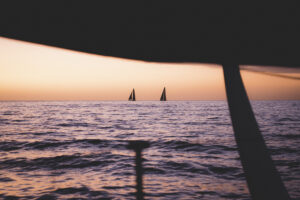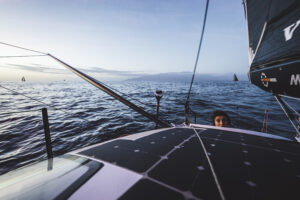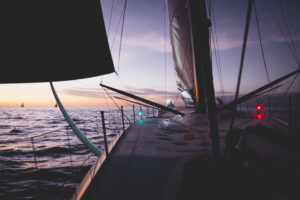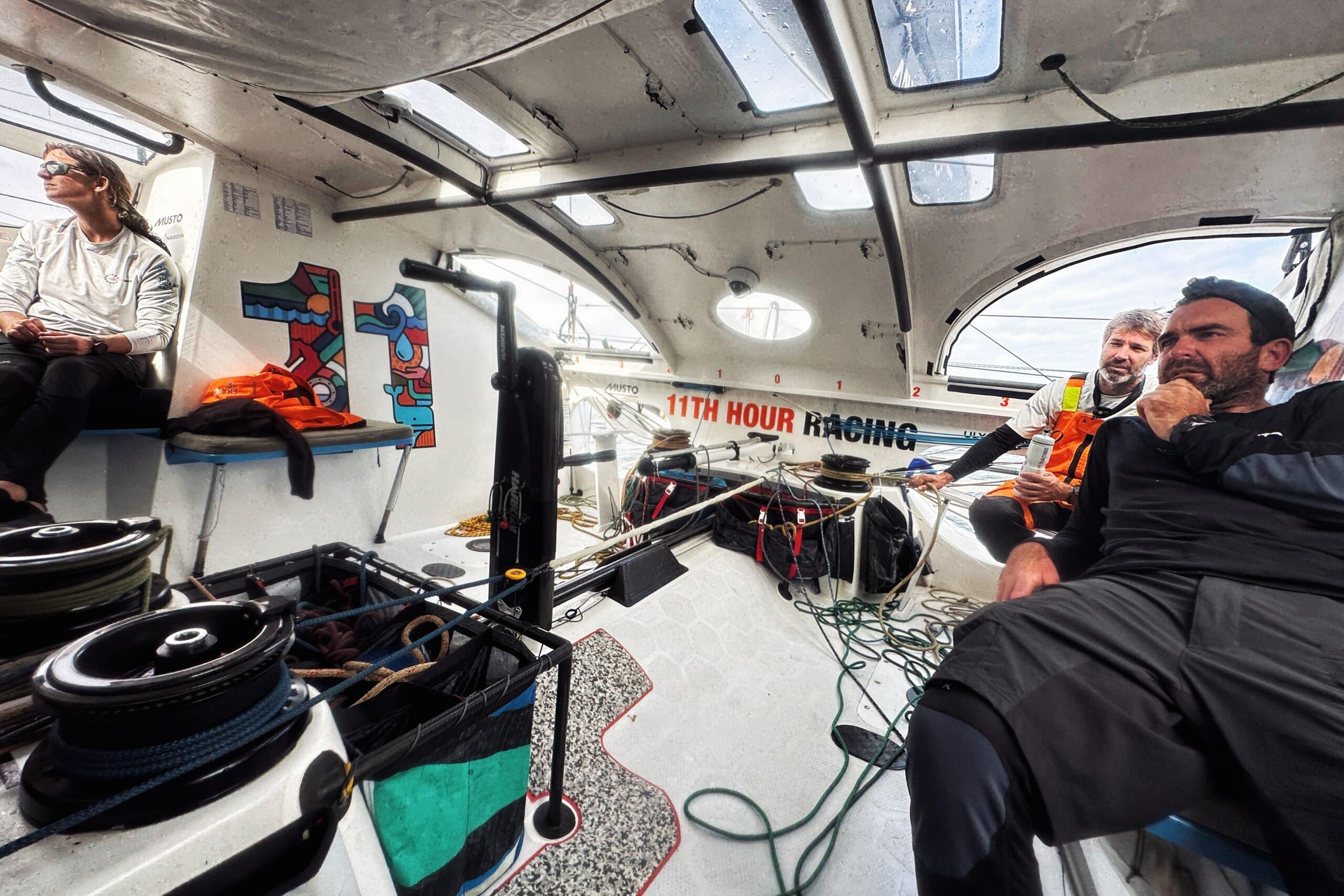LEG 2: ONBOARD UPDATES
As the crew from 11th Hour Racing Team races from Mindelo, Cabo Verde to Cape Town, South Africa, we’re onboard with Amory Ross, our Media Crew Member, with live updates from the boat!
Don’t forget you can track the fleet here.
📅 SunDAY FEBRUARY 12, 2023
🕒 0800 UTC
🌍 DISTANCE TO FINISH: 33.5 NAUTICAL MILES
💨 SPEED: 2.5 KNOTS
🥇 POSITION: 2nd
It’s neck and neck out there, at times we have been so close to Kevin Escoffier’s Team Holcim – PRB, fans have only been able to see one boat on the tracker.
As it stands, the top three boats; ourselves, Biotherm and Team Holcim – PRB are in a fierce battle to the finish line with less than 40 nautical miles to go. Team Malizia are slightly further behind and GUYOT Environnement – Team Europe are further behind the fleet with 91 nautical miles to leaders Biotherm.
“I trust us,” says Charlie Enright, “I trust us when things get tough. We’ve done well and made smart decisions so far. Of course there is a great deal of uncertainty during this approach to Cape Town and with that comes a great deal of anxiety – it’s all I’m thinking about.”
Expected Time of Arrival (ETA) – Leg 2 finish in Cape Town – is currently from 0830 UTC / 1030 local time in Cape Town, today. Here’s the latest from onboard with Amory Ross:
Here we sit, 35 miles from the finish of Leg 2 in Cape Town, three boats within three miles of each other and 2 knots of wind. It’s a crazy way to end a 5,000 mile journey, but that’s the reality of offshore racing! There are frequent weather systems and features that nobody can get past and it brings the whole group back together again, whether you’re at the front or the back. It’s often at the end of a leg as you approach land, too, so this is nothing new…
The important thing for us though, and I can already sense it onboard, is that however this pans out today (or tonight) we have to be really pleased with how we sailed this leg. The next 5-10 hours will be influenced to a degree by fortune, and if by chance we find some, or find none, we can’t let the result influence our perception of the last two and a half weeks. We have done a lot of things really well when we had the ability to control them, and that, going forward, is great.
With 0.7 knots of wind registering on the instruments right now this is going to be hard to make order of, but the goals are simple and short term. Sail whatever wind we have and keep the bow pointed at the finish. There is nothing more we can do! Who gets what cloud, who gets what wind, it’s all out of our hands and we have to make the most of whatever comes our way, when it does, and be ready for the next opportunity. Then the next, and the next. It’s what we’ve done all leg long so it shouldn’t come as any surprise that everyone’s in good spirits. If things go our way, wonderful. And if they don’t, we already have a lot to be excited for! This is just one leg of long race and we continue learning and continue growing.
We’re looking forward to seeing everyone in Cape Town soon (hopefully ;)!
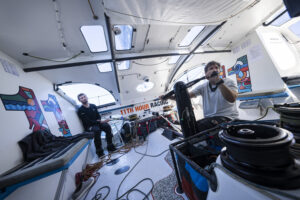
Jack Bouttell and Simon Fisher work together to keep Malama moving in the light winds.
📅 SATURDAY FEBRUARY 11, 2023
🕒 1000 UTC
🌍 DISTANCE TO FINISH: 269.3 NAUTICAL MILES
💨 SPEED: 8.3 KNOTS
🥇 POSITION: 1st
It’s the Leg that just keeps on giving …! As we move into what should be the final 24-30-hours of Leg 2 from Cabo Verde to Cape Town and the leading pack of 11th Hour Racing Team with Malizia, Holcim-PRB and Biotherm are all within 4 nautical miles of each other, compressed once again by the ridge of high pressure that is blocking the fleet’s path into Cape Town. Although our eyes are on the front of the fleet, a quick mention should be made of the crew on Guyot, who have made up a deficit of over 500nm, swept on with the winds from the west to lie just 71nm behind Mālama. This race is far from over …
As of the 1000 sched this morning, Mālama and Holcim-PRB are on identical tracks, taking the more northerly course along with Biotherm 15nm further north-west, with Malizia on their own, ploughing the more southerly path.
The first boats anticipated to arrive between 0900-1400 local time tomorrow (0700-1200 UTC).
Update from Amory Ross onbaord at 0844 UTC:
We’re getting there slowly but surely! Yesterday I wrote about Biotherm’s potentially race-winning flyer and not leaving Holcim and Malizia. I’ll pick up there because it explains a good deal of our strategy yesterday and overnight.
The two weather models that have been most accurate for us lately, the American GFS and the European ECWMF, were split on how best to approach Cape Town. The EC suggested a northern road, the GFS the south. The EC was the outlier amongst the rest and it seemed our trio was favoring the more conservative south. Then Biotherm started making tracks to the north; their flyer was looking strong. Then the GFS began trending north with every new update, until it agreed with the EC entirely. Playing the math game, too, our chances of a podium finish improved dramatically if we could eliminate the chances of a Biotherm / Guyot 1-2 where the south totally caves. So we decided instead to try and corral the fleet north.
The team did an amazing job squirting out from underneath Holcim, getting bow forward, and then getting up onto their line before fully sheeting on and going upwind and northeast last night, to an eventual intersection with Biotherm and the EC/GFS high road this morning. In doing so we brought Holcim with us, gained Biotherm and Guyot, but lost Malizia, still opting for a more southern course to Cape Town. When Si Fi runs fleet projections, in other words simulates where each boat will go based on optimum courses for the weather they have wherever on the map they are, we all arrive at the finish together. So, while we’ve worked hard to get ourselves in a safer position and worked hard to stay in front of Holcim, there is still a lot of uncertainty in the next 24 hours.
If there’s one thing we can be proud of and be happy for, it’s consistency. We have been consistently well placed and we have been consistently well paced, which is encouraging no matter the outcome in a days time. Onboard the mood is upbeat, excitable and optimistic with Cape Town and the Leg 2 finish 250 nautical miles away!
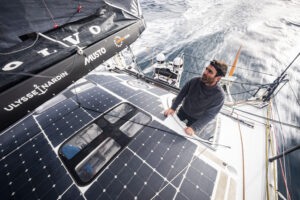
Charlie Enright pokes his head out the hatch to double check mainsail shape before going back in the cockpit.
📅 FRIDAY FEBRUARY 10, 2023
🕒 1100 UTC
🌍 DISTANCE TO FINISH: 567.4 NAUTICAL MILES
💨 SPEED: 11 KNOTS
🥇 POSITION: 2nd
At 1100 UTC this morning and 11th Hour Racing Team is back in second position with Malizia just ahead and Holcim-PRB just behind, as they approach the high pressure ridge that’s blocking a smooth run in to Cape Town. Just 1.1nm separate the three boats, which are within 10nm of each other NW/SW.
Charlie gave us this weather lesson this morning on what the teams have ahead of them:
“So I’ll give you a little update here at the end of Leg 2. We’re conducting this interview outside, which has basically been undoable for the last couple days on this leg! But what that means is we are engaging some high pressure, and high pressure means light air. The Saint Helena High has ridged out from its normal position in the middle of the South Atlantic, out across Cape Town, kind of blocking our way in.
“And so the whole fleet will slow down and compress. And I guess, in theory, boats ahead will have the choice as to where they want to stop relative to the boats that are coming up from behind! By that I mean in the East or the West, but basically, you can’t penetrate this ridge. So you have to choose where you’re going to engage it. And then the breeze should fill back in, and we’ll encounter the next feature, which is a col basically.
So there’s the split high in the South Atlantic, and then some of it hass broken off and ridged out the other side of Africa. And then there’s the low that we left with the front, just two days ago, in the south, and then another heat low over southern Africa, which leads to a giant void of no wind between us and the finish after the other giant void of no wind that we just traversed!
“So, however the hell we get through that, remains to be seen! We get new credible weather about every 12 hours … And then once we do punch through this atrocious weather feature, we’ll have perhaps a couple of hundred mile coastal race to the finish. And if you believe any of the computers that we use, everybody will finish within 10 feet of each other, despite the 16 days that we busted our … selves to get here! So that is it, that’s the end of Leg 2!”
Update from Amory onboard, at 0945 UTC this morning:
Sun-up finds ourself staring at Holcim to our left and Malizia to our right. Not surprising I guess but what a leg this has been! It seems it was inevitable given the multiple ridges of high pressure camped out to Cape Town’s west, and it seems inevitable given the seasonably reduced activity down here this time of year. The fronts and the lows needed to help push the St Helena high out of the way haven’t organized and the finish of this leg was probably always going to feature a full compression and restart. It was maybe wishful thinking to expect otherwise 🙂
It doesn’t make the pill any easier to swallow though. We feel we’ve sailed a really strong leg to this point. We arguably led the race west to the doldrums from Cabo Verde. We arguably led the race south after the doldrums. We arguably led the race east to the ice gate. Obviously, leading to the finish is the only thing that matters so those small victories don’t matter points-wise, but they are important because we should feel confident now that we can go and build a lead again. With a very tricky 500 miles to go, riding the highs and lows of the next two days is going to be crucial. Cape Town is close, but also very far. This will be a sprint to finish a marathon and we need to be focused.
The strategy for the time being seems straightforward enough. Keep ourselves near the front of the peloton. Be close enough to whoever is leading, if it’s not us, that when the weather gods finally give us good wind to the finish we can rely on our boat speed and our optimism to grind anyone down. We are too good on average to warrant a radical decision, even if it’s a flyer like Biotherm is on that ends up wining the leg. It’s hard to justify leaving Holcim and Malizia who are right here. So for now, with a few giant windless holes on our bow, we’ll make the most of what we have when we have it and otherwise play it safe. The time to push will come soon enough and we need to be rested and ready when it does!
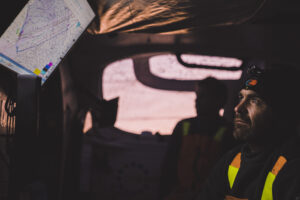
Charlie Enright analyzing the options at sundown.
📅 THURSDAY FEBRUARY 9, 2023
🕒 1100 UTC
🌍 DISTANCE TO FINISH: 902.9 NAUTICAL MILES
💨 SPEED: 16.9 KNOTS
🥇 POSITION: SECOND
After 15 grueling days, The Ocean Race fleet is in the final stages of Leg 2, the 4,600 nautical mile race from Mindelo, Cabo Verde to Cape Town, South Africa. 11th Hour Racing Team is in second place, and fast closing the gap on first-placed Malizia, now just 21.7 nautical miles ahead. As predicted by 11th Hour Racing Team Strategist Marcel, the crucial moments of the final hurdle of this leg are now coming into play.
In a brisk voice note left by our Skipper Charlie Enright last night, he describes the final phase of Leg 2 as “three races within a race”. Top of his mind is the high-pressure system currently moving around and under Cape Town which looks like it could cause a final compression of the fleet as they get caught in its light winds.
The biggest struggle for the sailors will be staying sharp and on top of the competition as the physical beating they have taken over the past week or so takes its toll and fatigue sets in. The opportunities for big gains diminish – meaning every decision counts, no matter how small.
It ain’t over ‘till it’s over and there’s everything to play for. Here’s what Charlie had to say:
“We have three races within a race, within this leg, between now and Cape Town. Firstly we have to get down and off the ice gate. We have a sail onboard – the A2 – which can help us and which Malizia and Holcim don’t have, they only have A3s, so that could be cool.
“Then we have to point and shoot up towards Cape Town, which will be a northeasterly trajectory and where we will encounter a ridge and the whole fleet will compress, and we’ll have to be on our toes: it will be first in, first out. We could bob around for a while, and anyone could pass anybody. Then we will end this Leg with a gruelling 100-mile coastal race.
“Four days left and three races within a race – we’ve got to stay fresh to the end.”
Amo’s update at 1045:
We’ve spent the better part of the last week staring at routes that bounce us off the ice exclusion zone in a string of gybes, trying to get south, under and around a supposed ridge sitting over Cape Town, before going north up its eastern flank.
The first alternative in the models appeared last night, maybe five hours before our first expected ice-gate gybe. The ECWMF, or EC as we call it – the European weather model – showed an immediate gybe and a northern road, sailing around the Cape Town cull to the west, and then down to the finish from above. It was at the time, intriguing, but seemed rogue and renegade, an outlier against all the rest.
We were trying our best to balance Holcim to the southwest and Malizia to the northeast, an unenviable position because there’s no good shift; you’re always gaining on one but losing on the other. We had been concerned about Malizia all night but comfortable with our leverage on Holcim, so we waited one sched to see if anyone else had taken the EC bait, which nobody did, and then, with consistently headed pressure on starboard and only a few hours until the ice gate, decided to go for it and gybed onto port; the numbers said it was time to go north and we took the chance. The next sched revealed Malizia had done the same, which was reassuring. They extended their lead through the night with better pressure to the north, and now we are where we are.
With 900 miles to go and three tricky days of sailing ahead, nobody is too despondent. We could see Malizia coming and always knew the conditions that brought them back wouldn’t last forever. They had to come back to earth at some point! The game now is staying within striking distance, and not letting Holcim get too much leverage to the south. Also, we didn’t have to spend all night and all morning gybing every hour at 44 degrees south, which was nice!
About what remains: theoretically, sailing high gets you a more direct route but brings you closer to the St Helena High and potentially less wind, while sailing low gets you more wind, but more miles. It’s kind of circuitous to sail too low. You can see Malizia, us and Holcim have fanned out and each have chosen a different lane… which will take some time to play out. To make matters more complicated, the western boats will get wind first, so the back half of the fleet should compress. It is all going to make for an interesting 72 hours and potential leg restart close to the finish, an all-stakes dash to the line in the lee of Table Mountain.
📅 WEDNESDAY FEBRUARY 8, 2023
🕒 1000 UTC
🌍 DISTANCE TO FINISH: 1,234.5 NAUTICAL MILES
💨 SPEED: 22.8 KNOTS
It’s fast and furious at the front of the fleet, as 11th Hour Racing Team continues to hold the lead, as the leading three boats each clocked over 500 nautical miles in the last 24 hours. 11th Hour Racing Team sailed 541.7nm, at an average speed of 22.6 knots [26mph or 41.9kmph] – that’s 623 miles or 1,003 kilometers. We know these boats can go further and faster in a 24-hour period – remember in the transatlantic delivery last summer, just two days after leaving Newport, the crew began the start of a 24-hour stint in fast conditions, sailing 560.54nm [621 miles or 1,037 kilometers] at an average speed of 23.36 knots [26.88mph or 43.26kmph], which would be the furthest recorded distance sailed by a boat 60-foot or less, and was the first to break the 1,000 kilometer barrier. But keeping safe and fast is what will win this second leg of The Ocean Race.
It’s easy to remember the distance to the finish from the 1000 sched this morning – Mālama has 1,234.5nm to go! The three lead boats of Mālama, Holcim-PRB and Malizia tracked steadily together until 2000 UTC last night when Holcim-PRB gybed south, taking them within spitting distance of Gough Island, uninhabited, except for the personnel of a weather station (usually six people) that the South African National Antarctic Programme has maintained continually on the island since 1956. Mālama and Malizia continued their path, south eastwards, with Malizia crossing our tracks twice. On the tracker they are current 0.1nm behind, with a north/south divide of 18nm.
Latest update from Amory Ross onboard:
It was just shy of midnight when we decided to gybe south and wave goodbye to the front we had been surfing for the better part of 17 hours. It was fast and it was furious, but as it began to roll over the top of us to the north it also began to lift us. Finally, it had lifted enough to allow us to gybe and go southeast (and not south), with the next waypoint on the map being the ice exclusion zone currently sitting at 45 degrees south.
Holcim, due west of us, gybed early and it was tempting to follow down, but the sooner you gybe the sooner you get south, the more time you spend gybing along the ice wall. So we waited until our own routing was calling for a gybe and committed then. Malizia to our north was on a similar line. As of this morning, all is still relatively equal. Malizia have been working hard to make a low mode work, so they are going forward on us, but guaging off. We don’t have that mode and may not have their wind so we have to be content sailing our own race here. It’s impossible to cover two boats on opposite sides of you, and sometimes the best thing to do when you’re getting pulled in two directions is to remove the distractions and focus on our own speed and the weather ahead. We seem to be doing a good job not getting caught up in the competition too much.
We’ve clearly crossed a geographical temperature transition because everyone was sweating all day though minimal layers just a few days ago, and now it’s full thermals, boots and foul weather gear. It went from being super hot and humid inside to being super cold and damp. Everything is coated in a film of water and it’s a good reminder of how much waterproofing work we have to do before leaving Cape Town in a few weeks. Electrical connectors and cables, bedding, clothes – it will be wet and it will stay wet for a long time; there is just a ton of moisture in the air.
We’ve heard rumblings of food rations and happy to report we’re doing just fine. With a longer leg forecast than planned I started minor rationing at the beginning of this leg and have built out a few extra days of full portions, and the cold-weather ramen bags get pulled out for the next few nights, so we’re in good shape there. The watermaker had a tough start to the day in the violent seas but, with some lessons learned over the last week, managed to get it back online relatively quickly. It has also come off it’s mounting which is a testament to the violence we’re enduring on these boats. Nothing seems strong enough to withstand the constant slamming! It’s good though. It all goes on the work list for Leg 3 upgrades and we leave the dock for the Southern Ocean stronger for it.
I don’t mean to insinuate that we’re already looking ahead to Leg 3 with 1200 miles to go in Leg 2, but in past races the mammoth undertaking of the Southern Ocean fell later in the race, whereas this race its longer and right around the corner. It’s something we are always thinking about out here while issues are fresh and solutions obvious. But yes. We are racing, too! Back to it… sched coming in shortly.
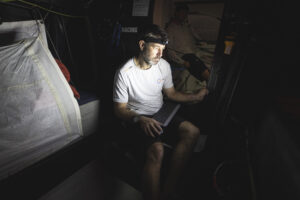
Simon Fisher downloading new weather at the nav station.
📅 TUESDAY FEBRUARY 7, 2023
🕒 1100 UTC
🌍 DISTANCE TO FINISH: 1,718.4 NAUTICAL MILES
💨 SPEED: 26.2 KNOTS
🥇 POSITION: 1st
And so the push down into the Southern Ocean continues … On the 1100 UTC sched this morning, 11th Hour Racing Team heads the leading pack of three with Team Malizia in second and Holcim-PRB in third. This tight group, separated by just 30 nautical miles north to south, are on an identical longitude with Mālama being the most southerly boat, and they are expected to gybe once again, pushing deeper into the south, but keeping north of the virtual ice gates, just 330 nautical miles away. The pressure will be on for the next 48 hours in the fast foiling conditions before the winds are expected to diminish on the approach to South Africa, which may allow the fleet to compress before the battle to cross the finish line commences, once again …
Update from Amory Ross onboard at 1145 UTC this morning:
I’m sitting here in the cockpit, foulies on for the first time this leg, staring at one of the two cockpit iPads displaying our performance averages. 27 knot average in the last 5 minutes, 27 knot average in the last 30 minutes. If this front we were on could carry us straight east, and if we didn’t need to get south, that’s well in the wheelhouse of outright monohull 24-hour record setting pace. These boats are capable of it for sure. Of course that’s not what we’re here to do, but it feels good to be going fast!!
We hooked into this front at sunrise and have been enjoying the speeds all morning. It’s really bumpy and really chaotic, but it’s flat and ‘relatively’ nice, allowing us these averages in just 22 knots of wind. As the bulk of the front slides across we’ll see a small build in wind strength and it’s the 24-26 knots that, as Si Fi says, “you feel less like a driver and more like a passenger!”
As fun as it would be to stay with this system, our game goes south. We’ve been hedging that way and when the time is right we’ll get off the ride and use what’s left on the backside to propel us down. The more time we spend in the south the fewer miles we sail (grab your globe if that doesn’t make sense 😉 but there’s not a lot of wind there at the moment, so it’s about connecting the dots and making the most of what we have here before getting down when we still can.
A little of me is bummed to be going south so soon. Some of the routes we’ve run had us passing Tristan da Cunha inside of 40 miles, which on a clear day would be close enough to see the volcanic summit of Queen Mary’s peak, 2,000 meters high. During my first race in 2011 I spent a week there with Puma Ocean Racing while we waited for cargo ship rescue after dismasting on Leg 1. Having never heard of Tristan before starting the 600 mile motor sail under jury rig, I had no comprehension for its uniqueness. While our time there was frustrating – our entire race was suddenly in jeopardy after 17 days – I really only came to appreciate how lucky we were, or how lucky I was, to get a passport stamp from the world’s most remotely inhabited island, after I left.
We hiked to the summit through four different climates, saw snow in the crater, nesting albatross, penguins, met some incredible people, played golf amongst cows, toured the islands’ facilities – most notably a Volvo powered generator and lobster processing plant. Since the finish of that race I have wondered if I’d ever get to see Tristan again. It’s not easy to get to. One ship of supplies every four months and passerby cruisers have to be in the middle of the South Atlantic. Even then, they are only allowed to stay anchored offshore for a few days. Sadly, we won’t be seeing Tristan at all, but that’s just a part of this race! How many incredible places do we see, never to experience. I’m thankful I had that time there and Andy Repetto and the crew that took care of us will always make me wonder what’s going on down here at Tristan.
For now, it’s just a bunch of boating buffoons blasting towards Cape Town at record setting pace! Hopefully a few albatrosses out there, too…
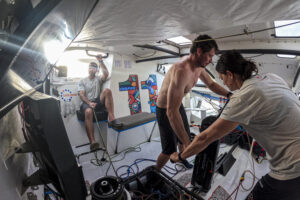
Charlie Enright in the driving seat with the mainsheet in hand while Jack Bouttell and Justine Mettraux grind.
📅 MONDAY FEBRUARY 6, 2023
🕒 1100 UTC
🌍 DISTANCE TO FINISH: 2,009.3 NAUTICAL MILES
💨 SPEED: 24.5 KNOTS
As expected, at the 1100 sched his morning, 11th Hour Racing Team has gybed to push further south, moving into second position on the leaderboard behind Holcim-PRB, who are now showing as 7nm ahead, with Malizia just behind the French team. The downwind speed of the latter is impressive and to have worked their way back to the front of the fleet just shows the potential of the German-flagged team. It’s going to be a battle all the way to Cape Town as the boats push as far south as they can while having to keep north of the Race-imposed ‘ice gates’ as seen in red on the tracker.
Update from Amory Ross this morning:
You’ll probably notice the updates are going to get a little shorter between here and Cape Town as the winds build. At 22 knots we’re back in the class of sailing on these IMOCAs where absolutely nothing is easy. Even walking (technically crawling) around is hard so you can imagine typing and editing. Apologies in advance!
Our zigzag to the south and to the east continues, with the rest of the fleet following a similar path. As we circumnavigate this High there are going to be variances in wind strength and direction, and those shifts aren’t always going to line up, so we’ll have to decide whether to prioritize the shift or the stronger winds. Downwind in these building seas and building winds the boat seems much more content in 23 knots than it does in 20. A little more pressure gives us a lot more speed and the race to Cape Town from here is a lot about speed – speed which nobody has more of than Malizia!
We saw their downwind potential first in Alicante when they came from miles back during the practice race to roll us, and Holcim too if they had the runway, and then we saw it again in the last days of Leg 1. This is clearly their sweet spot and we can hear their footsteps loudly. The same with Holcim who has taken a big chunk out of our lead overnight with a few really smart shifts. Great boats, great sailors … these last five or six days are going to be a battle that really tests both.
Onboard life is changing, too. Yesterday’s abundant sunshine and blazing heat changed overnight with cooler temperatures and cloudy skies this morning. I doubt anyone will complain. It has been a long few weeks of a damp, humid and hot boat, and everyone’s tired of sweating all day. How cold it gets as we continue south is anyone’s guess, so I may be eating my words!
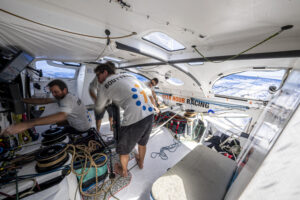
The team readies the autopilot-driven Malama for a gybe in a rare flurry of mechanical movement.
📅 SUNDAY FEBRUARY 5, 2023
🕒 1100 UTC
🌍 DISTANCE TO FINISH: 2,400 NAUTICAL MILES
💨 SPEED: 24.8 KNOTS
Let the race begin … again!. It’s day 10 of Leg 2 of The Ocean Race 2022-23 and the battle to reach Cape Town first is well and truly on. As the boats ‘turned the corner’ eastwards just after midnight last night, the leaderboard reshuffled and 11th Hour Racing Team went from last place to first by this morning’s 10am sched. They have played a patient game – prioritising the long-term vision, rather than ‘cutting the corner’ for short-term games. They have stuck to the game plan set by Charlie and Si Fi early on, to keep west, and sail their own race to get them through the Doldrums. West was better, now south is beautiful!
At the 1100 sched this morning they are 7.6 miles ahead of Holcim-PRB and sailing two knots faster – at 24.8 knots. It’s fast, and it will uncomfortable onboard. It’s now a game of dare – finding that balance between safety and speed, staying on the edge between the low pressure below them and the high pressure above.
Update from Amo at 0904 this morning:
It has been an interesting and exciting 24 hours for us as the trip south begins to turn east. The age old question of fleet racing is taking center stage: do you sail your own race or do you sail against your competitors? The answer of course is always somewhere in between, and we find ourselves a bit torn with every sched.
After crossing Holcim-PRB early yesterday, we were content to let them sail to our west, confidently aiming at the waypoint Si Fi had set for us, dropped where he wanted to begin gybing southeast. Our A2 spinnaker was allowing us to sail at deeper angles and we quickly extended.
But a squall brought them right back to us and the process began again, only this time we weren’t that much lower and we were still slower. After much debate the consensus seemed to be that we needed to change sails to match them and peel to the A3. “We can’t let him get bow forward,” was the concern. So Si Fi ran one more test, comparing our VMC [VMC is the Velocity Made good on Course. i.e. speed in the direction of the mark; VMG is the Velocity Made Good i.e. speed in the upwind of downwind direction], or speed to his waypoint, of A2 versus A3, and low and slow was still much faster than high and fast, even if it meant losing Holcim momentarily and even if it meant staring at his higher speeds on AIS all the time.
So we stayed on the A2. An hour later Holcim gybed and again came down to our line, only this time they were twice as far back. We almost got sucked into a match race when Cape Town is the goal, and it was a good reminder that there are other boats out here and we have to believe in our speed and in our plan.
Since then things have gone well. In a building breeze we have been in phase with the shifts and we’re sailing our downwind modes, using all the training we’ve done in these conditions to rely on the numbers and the data. It seems to be on pace with the fleet which is reassuring. If you’re fast you don’t really need to take risks. We may not be “fast,” but we’re not slow and that alleviates a lot of stress when it comes time to decide next steps!
From here it’s a bit of a zig zag course trying to gybe in the shifts and continue to use the windy features rolling west to east across the South Atlantic to get down, and to get east, quickly. We’ll keep zigging and we’ll keep zagging until we’re far enough south that we can skirt around the southern boundary of the St Helena High. At that point it’s just east, and eventually back north to Cape Town. We’re coming up on a relatively fast part of the course so the pedal is down and if the winds cooperate there should be some nice 24 hour runs in our future. Stay tuned!
PS. thought you’d like to know: the water tank is full again this morning!
📅 SUNDAY, FEBRUARY 5, 2023
🕒 0500 UTC
🌍 DISTANCE TO FINISH: 2,532 NAUTICAL MILES
💨 SPEED: 19.6 KNOTS
📏 DISTANCE TO LEADER: 19.4 NAUTICAL MILES
It would appear all the teams are dealing with minor issues onboard. From torn sails to electrical hiccups, this leg seems to be throwing up its fair share of challenges for everyone.
11th Hour Racing Team is currently in second position according to the tracker, the majority of the fleet has congregated in the west over the last 24 hours, leaving GUYOT environnement – Team Europe (who have ultimately held the lead for the majority of this leg) in light breeze to the east. The compression of the fleet will make for an exciting few days racing, however, life onboard is far from easy….
Check out this latest update from Amory Ross onboard:
It was hard to sleep. All I could think about was the watermaker. I had faith it would fire up primed – it had done that twice before – but how long would it last? Also twice before it decided, mid-cycle, to throw in the towel leaving us with less than a full tank of fresh water and worse, again in a struggle to resuscitate the machine that lasts many, many futile hours. The wondering during those moments – was that it’s last breath? Are we giving up? Kind of terrifying. The first time we brought it back it blew a hose right off the pump. Air in the system. The second time we brought it back we had a high-fly on the foil and undoubtedly sucked air into the water intake (on the keel fin) that the pump couldn’t handle. Air is the obvious enemy.
That is why I was hopeful this morning: conditions are mellow. We are sailing downwind in 10-12 knots and both boat and sea state are relatively flat. All things are stable and there should be no reason for stray air to enter the system. I closed all other water-hungry systems, closed my eyes, and flipped the manual override switch. Thankfully, it started, it filled the tank 45 minutes later, and I turned it off, still primed. That was a first in this three or four day battle, and a huge relief. We have a full tank at least. Another day of drinking and eating.
Hypothetically speaking, let’s say the watermaker decides to cooperate the rest of the way to Cape Town. Maybe in spits and spurts, but let’s say it gets us there without having to resort to the tiny backup we’ve never rigged or the manual hand pump in the emergency spares kit. It’s the kind of thing that, going into a potential 40 day leg in the Southern Ocean, could turn out to be a blessing in disguise. Up until now this watermaker has not failed. And honestly it may not be the watermaker. There are a number of components along the way that could be giving the watermaker bad information or bad water. Regardless, it has been too reliable and we’ve never had to fix it or service it underway. We have spare pieces and components to fix just about everything else onboard, but this slipped through the gaps.
We blew a fuse at some point and realized we didn’t have the right kind of fuse in our spares. Si Fi wrapped the blown fuse in spare conduit and we jammed it back in its place and that worked. Next attempt would have been aluminum foil from a chocolate bar wrapper. We realized the 12 volt electric connectors required for the spare watermaker (this boats’ original watermaker, for double handed configuration) had been downsized and were connected to the fresh water pump, and the current watermaker wired to 24 volts. So there would have been no power readily available for the spare, wire splicing required, and no way to get water out of the fresh water tank once we lost the fresh water pump. We realized that a lot of the hosing is difficult to access and there’s no easy place to consider mounting the spare.
Long story short, we have a lot of work to do in Cape Town to ensure that when we leave for the deep and remote South, we have every chance of fixing a similar watermaker situation, but also a more plug-and-play solution for the spare. Water is essential and in hindsight, we are lucky never to have had these issues before but we are lucky to be having them now, with benign conditions to repair and troubleshoot and only a week left, not four.
To be honest I’m a little checked out with the racing. Biotherm is in sight to weather, barely visible on the horizon about a beam of us, and Holcim is somewhere to leeward, going fast as usual. I know we are still pushing south before beginning the long bend around the St Helena High, and that everyone is still jostling east west to find the best compromise between sailing less distance and making sure you’re not too close to the sun. Other than that, just happy to be able to fill my waterbottle and make Charlie another coffee.
Today is a glass mostly full day, for sure!! (See what I did there?)
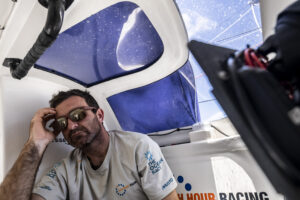
Charlie Enright drapes a microfiber towel over the cockpit window for some protection from the sun during his two hours at the helm station.
📅 SATURDAY, FEBRUARY 4, 2023
🕒 1000 UTC
🌍 DISTANCE TO FINISH: 2,681 NAUTICAL MILES
💨 SPEED: 10.7 KNOTS
📏 DISTANCE TO LEADER: 86.5 NAUTICAL MILES
As 11th Hour Racing Team sail downwind in relatively light breeze, the fleet is finally getting away from the coast of Brazil. Yesterday was, according to Jack Bouttell, ‘the crux point of the east/west split in the fleet coming back together’ as they decide how to approach the ‘train’ of the low pressure system building beneath them.
However, although racing is the priority, the sailors onboard Mālama have something else preoccupying their minds… a broken watermaker.
Hear more from Amory Ross with this onboard update:
Earlier in my update I said everything was okay but what hasn’t been okay is the functionality of our watermaker, which is touch and go at the moment. A few nights ago I went to turn it on and it refused to prime. Usually this means there is air in the system, which requires just a simple bleed from a valve before you’re up and running and making water. Only this time it wouldn’t bleed and it wouldn’t prime. Try as I might all night I could get no prime. When Jack got up I brought him into the fold until we finally got rid of the air sometime in the morning, albeit at a reduced capacity. Instead of pressurizing to 8bars of pressure it’s now only 6, and it requires manual override of the power and pump. We checked every hose, every filter and every clamp for air leaks but could find no red flags. Either way, we filled the tank and hoped like crazy the problem was behind us.
A tentative mid-day refill went without issue and going into last night I was feeling a little more comfortable with the prospect of it being reliable enough to get us to Cape Town. It came to life with a little hesitation but soon found it’s rhythm at 6bar. Then, when the water tank was about 1/3 of the way full, it quit. I could see air in the hose from the keel intake and the pump simply gave up. Sure enough, the system had lost its prime and it was back to square one. Exhausted from the day before and with enough water to get us through the night we pushed resuscitation to this morning.
At sunup and with the tank nearly empty, we had new strategies and new workarounds, but no new results. After hours of trying in vain, It was time to get out the spare watermaker, we agreed. Moments later, with Jack on the bow for a gybe, I figured to give it one more try and miraculously, it obliged. I don’t know why, and that’s part of the problem. I topped off the tank, our water bottles and anything else I could find and shut it down to cool off.
I have zero confidence in its ability to create drinkable water for us reliably, and their seems to be no answer to its ailment except a little bit of luck and a lot of persistence. That’s no recipe for one of, if not the most, important commodities onboard. Our spare is always an option but it makes water at a much slower pace and would require a ton of work to install. Water is everything out here. Not just to drink, but we need it to hydrate our food, too. We need water.
Fortunately, conditions are good for more investigation. It’s calm and the boat is flat, relatively stable. We’ll keep looking to find answers while being a little more rational – pun very much intended – with our H2O consumption. We’re sure everyone’s probably dealing with things too and it’s all part of crossing oceans so we’ll make it work one way or another!
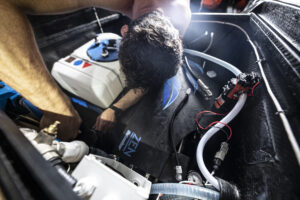
Jack Bouttell working to restore the watermaker onboard Malama.
📅 SATURDAY, FEBRUARY 4, 2023
🕒 0300 UTC
🌍 DISTANCE TO FINISH: 2,737 NAUTICAL MILES
💨 SPEED: 14.5 KNOTS
📏 DISTANCE TO LEADER: 107.6 NAUTICAL MILES
Short update from @amory_ross as the team battle a few unexpected challenges onboard (more to come):
The battle of east vs west continues into Day 9. Us, @teamholcimprb and @biotherm are on a converging course, with – as expected – @teamholcimprb using what little wind is left before the High to cash in on their fewer miles sailed and cross down in front of us, probably 10 miles or so on the bow. If we had a little more wind or even a cloud or two, we’d be right there with them.
But in the grand scheme of things all is okay! 10 miles is nothing and there are tons of miles left on the map 🗺️
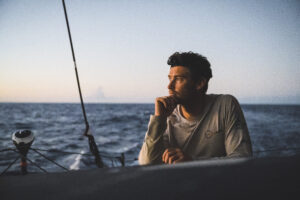
Jack Bouttell sticks his head out of the hatch for a moment of fresh air at the day’s end.
📅 THURSDAY FEBRUARY 2, 2023
🕒 1230 UTC
🌍 DISTANCE TO FINISH: 3,078.6 NAUTICAL MILES
💨 SPEED: 15.9 KNOTS
📏 DISTANCE TO LEADER: 82.1 NAUTICAL MILES
This morning, 11th Hour Racing Team maintains the fourth spot as the race south continues. Now 82.1 nm behind leader Guyot environnement – Team Europe, the fleet is approaching the high-pressure ridge, where the air is heavy, and it sinks, which makes the conditions for the crew onboard Mālama very stable with typically sunny skies and calm weather – not really what’s needed for their charge south towards Cape Town.
We may see some slower speeds on the tracker, and a compression of the fleet in the coming hours and days, but as Mark Towill, the team CEO said this morning: “there are plenty of opportunities still left!”
Just in from Amory Ross onboard:
February 2. Groundhog Day in the States! It’s not quite the case out here but it seems like it’s going to be a theme for a few days at least. The east-west posturing complete, with yesterday’s subtle reshuffling in the stronger-than-forecast winds and squalls complete, everyone more or less appears resigned with their lane south. We are still “bow back,” meaning to-the-north-of, Biotherm and Holcim, but as the winds lighten nearing the ridge of high pressure, they will have a harder time shifting lanes like they were able to yesterday, and the closer you are to the high the lighter the winds get. So while we are farther from Cape Town and while our outside track has us sailing more miles, it’s still our belief (and that of our routing) that the surplus wind in our future farther to the west and farther to the south will more than make up for it. That’s our hope, at least! But the next 24-48 hours are going to be groundhoggish for sure. 10-15 knots, flat water, lifting ever so slowly until we finally gybe on to our spinnakers and go east.
Onboard temps are at an all-time high while conditions for outdoor boating are perfect. We’ll get to do none of that! But we are fully protected from the sun and that has been a really nice development. Usually by now everyone’s completely cooked, chapped, covered in long layers and big hats and buffs, head to toe in sunscreen and full of salt and sun rash. Nobody is missing that. Our protective roof has given plenty of shade, and we’ve just learned to accept the inferno of stale, steamy air. Life is all about compromises 🙂 This part of the world is always going to be hot one way or another. All you need to do is look at the suggested routes taking us south to the ice gates where we’ll soon all be really cold!
📅 WEDNESDAY FEBRUARY 1, 2023
🕒 1100 UTC
🌍 DISTANCE TO FINISH: 3,438.9 NAUTICAL MILES
💨 SPEED: 22.6 KNOTS
📏 DISTANCE TO LEADER: 117.6 NAUTICAL MILES
This morning 11th Hour Racing Team maintains its fourth position, 119 nautical miles behind Guyot Environnement. It should be remembered that the boat on the longitude closest to the finish point will always top the rankings and Mālama is now the most westerly boat, with Malizia tucking in behind on a similar track. What will be on Si Fi and Charlie’s minds now will be the turning point around the St Helena high pressure system, which you can see clearly on the tracker below. At what point will they turn downwind and south, to be swept through the Southern Ocean, destination Cape Town? Scrolling 24h on through the tracker and ahead there looks to be patchy conditions which the teams will have to pick their way through, no one wanting to be left behind as it could become a rich becomes richer situation …
As the Easterly boat, Guyot will have a more downwind and faster approach to reach the ‘turning point’, while we will be reaching [wind over the side of the boat] for longer. It’s now down to nerves of steel – who will get there first and take advantage of the next phase of the course.
Just in from Amory Ross onboard:
I’m happy to report that I didn’t jinx the squad with yesterday’s update. The last 24 hours have been what I guess are best described as transitional. It was mostly tradewinds-like conditions, maybe 10-15 knots, with a few last clouds perusing the ITCZ perimeter to keep us on our toes as we resumed the march south.
Now, we’re firmly in the trades. Winds are well above forecast and while the sea state is a bit lumpy, we’re chewing up the miles at a mode we’d call “fast upwind,” that’s slightly eased from upwind. When we’re true upwind we sail with the wind about 60 degrees off the bow; now it’s about 80-degrees, so sheets are ever so slightly eased. We’ve been averaging 23 knots of boat speed in 20 knots of wind, which is pretty remarkable. These boats and these foils shine in these conditions and as slammy slammy as it’s been after a few days of calm, we’re going fast and that’s always fun! Traditionally the 24 hour record is set between here and Cape Town so you can bet we’ll be watching those numbers closely as things get a little more reachy down the track.
Speaking of track, I’m sure the tracker is confusing… I’ll try to make sense of why we are where we are. The strategy going into the doldrums was to get west for two reasons. Firstly, it’s usually narrower in the west. That part didn’t pan out. The curtain to the southern hemisphere lifted for everyone, simultaneously, whether you were west, east or in the middle. Kudos to Guyot for rolling the dice there. But the second reason to set up west is to better position yourself for rounding the South Atlantic high, and that story is just unfolding. This is Chapter Three.
Over the next week everyone to our east will probably want to come down to our line. Too far east going into the high and it gets really light. It’s always tempting to cut the corner so to speak, but it rarely works. So while the competition may be numerically closer to Cape Town and may be in better wind for the time being, if we can hang on out here to the west, our lane will come good eventually. We have, in essence, already done the hard work to get here and now we have to hope they either get stuck too close to the high, like Icarus and the sun, or spend their gains to join us. That’s when we get our turn. For now though the watch brief from Si Fi is simple. Stick to the plan and get south. Don’t be distracted by the short term successes of those to the east. Sail our race and let them come to us!
📅 TUESDAY, JANUARY 31, 2023
🕒 1200 UTC
🌍 DISTANCE TO FINISH: 3,753.4 NAUTICAL MILES
💨 SPEED: 19.8 KNOTS
📏 DISTANCE TO LEADER: 67.8 NAUTICAL MILES
As of midday UTC this morning, 11th Hour Racing Team is in fourth place, 67.8 nautical miles behind GUYOT environnement – Team Europe, who are a little over 140 miles to the East, with Biotherm and Holcim-PRB both on identical tracks 55 nautical miles in the same direction. Malizia, who seem to have had an easier time of the Doldrums than the leaders, are north west of 11th Hour Racing Team, 42 nautical miles astern.
Could the Doldrums be a thing of memory for the five sailors onboard Mālama? We all hope so – those of us ashore, glued to the tracker, willing and wishing to see an improved progress south, as well as for those onboard, but as Amo shares below, it is with some nervousness that they head into the southern hemisphere …
Just in from Amory Ross onboard:
This is always a dangerous blog to write, so I do so with trepidation, but it seems like we are out of the doldrums and back into the trades. I’m writing this under clear skies and 14 knots of wind, 20 knots on the speedo, bow in the sky, reaching at grate haste due south. Life, for the moment, is good!!
Just a few hours after crossing the equator and entering the Southern Hemisphere (albeit unceremoniously and without visit from King Neptune, occupied elsewhere to our east) the winds began to build. First a cloud, then another, and with that it seemed the skies parted and we had broken through. No more massive fluctuations in wind strength and direction, no more wondering when the march south will begin or who will get out first. Even with clouds on the bow, onboard opinions based entirely on emotion have us convinced the doldrums are behind us.
On the doldrums… it really wasn’t that bad. There were no squalls, there were no clouds, it really wasn’t that hot. Sure, there was plenty of drifting, but there always is. Our course was almost always south, we were usually drifting at a few knots, at worst, and we kept plodding through without incident.
Now of course we spend the time watching the tracker. With the fleet neatly aligned east to west, is everyone going to exit en masse? Or is someone (re: us) going to get a jump? These are anxious hours as our short-term fate all the way to the west plays out sched by sched.
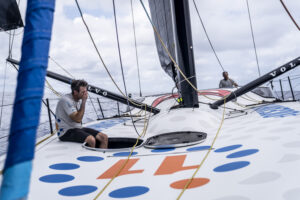
Simon Fisher takes a breather on deck where, even in the sweltering doldrums, it’s cooler than inside.
📅 MONDAY, JANUARY 30, 2023
🕒 1100 UTC
🌍 DISTANCE TO FINISH: 3,957.4 NAUTICAL MILES
💨 SPEED: 2.7 KNOTS
📏 DISTANCE TO LEADER: 41.0 NAUTICAL MILES
At 1100 this morning, 11th Hour Racing Team is the most westerly boat in the leading pack of four with Holcim -PRB, Biotherm, and then Guyot environment – Team Europe the furthest east. On the tracker, the four boats almost line up west to east in latitude, with Team Malizia 40 miles astern, north west of Mālama. Everyone is hunting for that elusive puff of wind that will get them out of this area of painfully slow progress. This morning we recorded with 2.7 knots of boat speed, with Guyot the fastest on the course at 6.8 knots.
If you want to understand a little more about why the Doldrums exist, and what impact they have on the weather elsewhere on the planet, then sit down, take a coffee and listen to Mr Ross, today’s teacher on all things Doldrums:
Well, there’s not a lot to say about the racing! Today began very much like yesterday ended, which ended very much like it began: becalmed. They don’t call it the Doldrums for nothing, but these last 48 hours have been particularly uneventful as far as Doldrums crossings go. That said, we still have managed to get south and be furthest west [re: original goals], and in some ways better than the rest. Even an average of 1.0 knot is 100% faster than someone doing 0.0, and there were quite a few scheds from the competition with double donuts. Progress is always relative.
I’m fascinated by this part of the world. We get so locked into weather wherever we call home, but it’s fun to consider there are places like this that are just always the same, yet so heavily impact weather around the world. In New England, where I’m from, summers are hot, humid, largely convective during the day, nights are cool and calm, and weather is driven by warm and cold fronts moving across the US west to east, pushed around by pacific-born highs, lows, and the upper air jet stream. Winters are kind of the same, just much colder, less influenced by the sun, more dependent on the warm waters of the Gulf of Mexico. Anyone curious enough can build a similar synopsis of your local weather patterns but they likely change throughout the seasons. Not here. It’s like this all year here.
Put simply, the ITCZ, short for Inter Tropical Convergence Zone, is where the northeast tradewinds and the southeast tradewinds smash together and go upwards, very very high into the sky. The tradewinds that form the ITCZ are driven by the sun, its rays most intense at the equator. As it heats the waters here, the humid air rises, drawing in air from the north and the south to fill the void, creating the year-round ‘trades’. That same rising air at the equator, combined with the air being forced upwards by the converging tradewinds, produces huge vertical movements of warm, wet air, and, as it rises, it expands and cools, creating towering cumulus clouds nearly touching space that then turn to lots and lots of rain and, ideally, wind. This narrow band of cloud is always here, and, much like ash from a volcano found continents away, these clouds that reach up to 55,000 feet tall can impact weather on a global scale.
Unfortunately, there just aren’t many of them right now. This has been, by far, the clearest and calmest of any crossings I’ve made to date. No squalls, very few big clouds and overall, a really stable picture on the horizon. For sure it’s a result of the weak trades; there’s no wind smashing together. But it’s also winter, and the ITCZ is much farther south than when we usually first cross in October. I wonder too if the warmer oceans are having an influence, lowering the gradient flow of cold air and water towards the hot equator that fuels the ITCZ. Who knows…
What I do know is that today will be very much like yesterday. Hopefully we get a bit of a break somewhere along the way south! As nice as writing this with breakfast on the bow is, it’s getting a little old 🙂
SUNDAY, JANUARY 29, 2023
UPDATE FROM NAVIGATOR, SIMON FISHER
I’ve been telling myself when I get a quiet moment I’ll write something down about the leg so far, only to arrive at the end of each watch both busy and exhausted. It’s a pattern that has repeated itself fairly consistently since we left Cabo Verde and battled our way south to the Doldrums.
Typically when you think you have arrived at the point of rest, something transpires that means you either have to go back to the computer to look at the situation or back on deck to change sails, do a maneuver or stack the boat. By the time I’ve arrived at my bunk, each time I’ve been too tired to even reach down to my pocket to retrieve my earphones, not that I’ve needed music to help me to sleep. Every bit sleep has been welcomed but punctuated at least hourly by the steady flow of position reports and wind shifts.
That said, though, it has been fun playing the strategic game as we headed south through the trades, it has however felt a little more like snakes and ladders and less like chess on occasions as gains are quickly won and lost. It now remains to be seen if the work in the trades is cancelled out by the randomness of the Doldrums. It has been a unusually tricky Doldrums to figure out, there is still no simple and obvious way through, short of sailing all the way to the Brazilian coast, so it’s going to be interesting to see how the next few days play out as we all aim our bow south and do our best to get through, ahead of the next guy.
So far it has been good fun, an opportunity to study the clouds and follow your gut, as opposed to having to think about how we mark our opposition. We are still headed downwind and the wind is almost 180 degrees out from the forecast but progress seems to be good for the time being! I could just be happy not having to try and think while getting my brains shaken about through fast sailing.
In recent days I’ve wondered if I should have been training by taking my computer with my into an industrial washing machine and putting it on spin cycle! Now, however, I’m enjoying a moment sat on the foredeck in relative calm feeling the wind across the deck having been able to leave the cockpit for pretty much the first time since departing Alicante.
It’s starting to rain but I really don’t mind. It’s just nice to be outside and the presence of the cloud overhead means the wind is pushing us along steadily to the south. All is good onboard as people finally get a chance to catch up on a little sleep and tackle the little jobs that have been outstanding for days. The frenetic pace has definitely slowed a little now that we are in the Doldrums but as they say, a change is as good as a rest, so I think we’ll make the most of it.
📅 SUNDAY, JANUARY 29, 2023
🕒 0900 UTC
🌍 DISTANCE TO FINISH: 4,025.4 NAUTICAL MILES
💨 SPEED: 8.2 KNOTS
📏 DISTANCE TO LEADER: 24.1 NAUTICAL MILES
And so it begins, the critical 24 to 48 hours of painfully slow progress across the Doldrums as the team onboard Mālama pick their way across this section of the racecourse. According to team CEO, Mark Towill, their westerly position should, in theory, be better for a quicker exit, but, he also admits, “it’s a lottery ticket as to who gets out first”.
Looking at the tracker this morning at 0900 UTC, and of the three front runners, we have recorded the highest speed at 8.2 knots, with current leader Biotherm at just 1.5 knots – that’s 1.7 miles/hour or 2.7 km/h. To put this in to context, the average walking pace is 2.5-4mph or 4-6.4kmph.
But every inch, every meter carried forward is one step closer to exiting the ‘pot au noir’ as the French call the Doldrums. It is likely that whomever gets into the South East trade winds first will have a good advantage going into the next stage of this long leg to Cape Town.
The game of snakes and ladders is intense as the teams work from cloud to cloud in the heat, sailing the boat in the airless cockpit, under cover, with no respite from the heat, and no fresh air. Late last night, trimmer Jack Bouttell shared this update on what living conditions are like onboard. If you are eating your breakfast, you might want to stop, or a wait a little …
Day 3 in the dome – from Jack Bouttell
Even though our boat is more orientated for crewed sailing, rather than the short-handed [one or two sailors onboard] set-ups of the others, the small living area and closed cockpit is something we are still getting used to. It’s a novelty in the fact that we are protected from the waves rolling down the deck like on the VO65s, but there is a definite feeling of cabin fever sometimes.
With five of us sharing the space of something equivalent to the size of an en-suite bathroom, we share everything. We sleep two at a time right next to each other separated by a thin piece of sail material. We share our good moods and bad moods and of course, the odours … of which there are plenty. And they aren’t exactly the essence of elderflower.
Charlie worse than me, but both of us had the runs for the first couple of days. Obviously we ate something a bit dodgy during the Cabo Verde stopover. Have you ever shared a studio apartment with someone who has the runs? Yeah? Now imagine five of you in there, and trying to sail a boat at the same time.
It is even harder inside when it’s hot. The roof creates a greenhouse effect and we sweat the day away, trying to get as close as possible to a small fan for some relief. I’m looking forward to when it’s cold and wet again – that will feel pretty damn nice!
Just in from Amo 1045 UTC:
The first signs began at 0400UTC, not long before sunrise. First a couple of bizarre, un-forecasted shifts: 20 degree lefties that weren’t supposed to be where they were. Then came the first clouds, and then the first rain. And with that, we said goodbye to the brief time in the NE tradewinds and hello to the Doldrums. Suddenly, sails were slatting and we were going upwind with downwind sails, then upwind with upwind sails, then not much of anywhere with it-didn’t-really-matter!
Without sunlight to see, or it’s heat to energize the cloud engine, nights can be a little catch as catch can. Si Fi didn’t get a lot of rest in the early hours this morning with a transition of his own from studying weather models and gribs to real-time satellite and infrared imagery. We are now in a part of the world where no weather-predicting algorithm works and the only consistency is it’s inconsistency. You have to use your own eyes (or the ones in space) to make the most of the ever changing landscape between us and the SE trades.
Unfortunately that landscape is growing, too. There is a ton of instability to the south, and those southern hemisphere tradewinds we so desperately seek are currently as diminished as the northern trades were when we left Cabo Verde. An ITCZ that a few days ago was looking relatively clean, with clear, narrow convergence lines and defined cloud structure, is now a total mess. This could be a long, difficult few days or more, and the leader could emerge not 60 miles ahead but 600. We’ll just have to do our best to keep getting south and find our own way through the maze. It will be a different path for us all and you can only hope ours is a little easier than the rest!
📅 SATURDAY, JANUARY 28, 2023
🕒 0900 UTC
🌍 DISTANCE TO FINISH: 4,295.9 NAUTICAL MILES
💨 SPEED: 17.2 KNOTS
📏 DISTANCE TO LEADER: 31.9 NAUTICAL MILES
And so the zig-zagging goes on as the five teams head south, destination Cape Town. But the obstacle on the racecourse they all have their eyes on is the Intertropical Convergence Zone, also known as the Doldrums, now 280 nautical miles (518km) to the South.
This patch of Atlantic Ocean around the equatorial region, is where the northeast and southeast trade winds converge and it can be a complex crossing with its calms, sudden storms and light, unpredictable winds. Si Fi will be focused on what point is best to enter, for the quickest exit south.
As Charlie shared in last night’s update, “This race isn’t going to be won here, it’s going to be won or lost in the Doldrums. [Our plan is to] Go in there close, and see what happens. Eventually everyone will end up on port and head south at the point they want to cross the Doldrums. Once you are in the Doldrums, it’s anyone’s game.”
Onboard update from Amory Ross:
The tradewinds are back! Though a far cry from the old days where downwind in 20 knots you’d be basking in the tropical sun, warm water and flying fish sweeping down the deck, now we’re a bit cooped up in the sweat box staring longingly through the window… But it has been a fun 24 hours of relatively comfortable high speed sailing! We know too though that it will soon come to an end.
In essence the first of this Leg’s three chapters is nearly finished. Given the complex forecast, the biggest risk in approaching this doldrums crossing was not being west enough, and we and Holcim are the westernmost boats with the frontrunners pointed south. The farther west you go the longer you have wind and the narrower the doldrums are, so the two of us are well set up in that regard, with Biotherm only 20nm to our east. We’ve done everything we can to get here in touch with the leader and at a longitude we think will give us an optimal path through.
The leg’s second chapter begins when these 20 knots first taper and we feel the effects of the ITCZ transition, or inter tropical convergence zone. The first boat in isn’t necessarily the first out, and your success or failure is somewhat dependent on the lane you choose, but also a bit of luck! The three of us are in a relatively tight grouping but then again sometimes one cloud, one squall makes all the difference. Race winning breakaways, unintentional splits and fleet inversions are always a possibility.
With that said, we’ve maintained this leg would be decided in the doldrums and it’s not untrue. The first boat to finish Chapter 2 and escape the ITCZ, first to feel the SE trades, can turn the page to Chapter 3, a long fetch to Cape Town. Even as I write, our 20kts is now 16. Chapter 2 and the next week of up and downs is near…
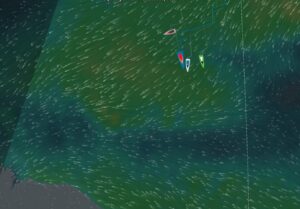
📅 FRIDAY, JANUARY 27, 2023
🕒 1200 UTC
🌍 DISTANCE TO FINISH: 4,496.7 nautical miles
💨 SPEED: 15.9 knots
📏 DISTANCE TO LEADER: 5.8 nautical miles
It’s a game of cat and mouse as the five IMOCA teams point their noses toward the Doldrums around 450 nm to the south. At the midday sched today, 11th Hour Racing Team is 5.8 nautical miles behind leaders Biotherm, having gained 5.3 nautical miles since the last sched.
Update from Amory Ross onboard:
I’m no longer pondering my writing material on the bow which, besides the pale skin thing, is probably a gain for us all. It means there’s more water which means there’s more wind which means we’re going faster. Yesterday’s 10-12 knots is todays 14-16. Not a significant bump but these boats respond quickly to small increases in wind and we are nearing the range where foils come into play. Also coming in to play are sails. There are two camps in the fleet out here: those with A2s and those without. A2s are the big white spinnaker-y things. It’s clear Holcim and Malizia chose not to bring theirs in favor of another sail. Their black A3s require higher, hotter angles to get up to speed and so while us and Biotherm have managed to stay relatively low and in the same stretch of ocean, we’ve lost touch with Holcim, spearing off to the northwest and out of AIS range. You can see the same difference in angles between Malizia and Guyot, Guyot with their A2 has been much lower all the time and they’ve done well to shave the miles and sail through the back of the fleet.
The relatively benign, tropical downwind conditions mask a busy and challenging 24 hours of gybes without much sleep. It’s a slow march west to get through the doldrums in as narrow a band as possible, but the trade winds are refilling from the east, so the compromise is south with the wind and west when the shift allows. The routing is progressively pushing us further west all the time, so in essence we go west when the shift allows, and as it lightens, get pointed south again and hopefully on a good number. When you’re back into the breeze, start looking for the next shift to take west. Eventually our zig zag course will get us north over our doldrums transit point and from there, to the south we’ll go!
📅 THURSDAY, JANUARY 26, 2023
🕒 1000 UTC
🌍 DISTANCE TO FINISH: 4,684.5 nautical miles
💨 SPEED: 8.6 knots
📏 DISTANCE TO LEADER: 4.5 nautical miles
What a difference the start of Leg 2 of The Ocean Race 2022-23 is, to Leg 1. As the race set off from the Spanish city, the teams were quickly into 40 knots and a terrible sea state – described by Charlie as a ‘baptism of fire’, but yesterday’s start from Mindelo, Cape Verde was the near opposite. The five IMOCA teams completed the short inshore course in just 7-8 knots and are currently only 100 nautical miles or so due south of the departure island.
11th Hour Racing Team is in third place, 4.5nm off the leader Biotherm, and 1.7nm behind Holcim-PRB. Team CEO Mark Towill shared his thoughts this morning. “The biggest decision for sailors right now is where to cross the Doldrums. Normally, the Doldrums are narrower in the west, and wider in east so the theory goes that the further west you go, the easier the passage, but you have to sail more miles to get there – it’s a trade off.”
With the same light air and unstable conditions anticipated for the next day or two, Mark predicts the fleet will stay relatively close to each other, not looking to take any big risks this early in the race.
Onboard update from Amory Ross:
The plan was to take my fresh morning coffee to the bow to write. We need weight forward in the light winds and I figured I’d get some quiet time out of the busy cockpit to find my thoughts. But the only relevant thought I’ve had is that, an hour and a half later, I completely forgot about writing. I’ve just been staring at the ocean, at the last of the Cape Verde islands to our east, at the seabirds aggressively chasing fish on our bow, at my super pale legs, new to this IMOCA outside-ness. I’ve been listening to the waves, to the flapping spinnaker, the occasional keel cant motor, and almost nothing else. I’ve been thinking about the start of The Ocean Race, the maelstrom of a week that followed, our four days of boatwork in Sao Vicente, and now this, a two week journey from the north to the south, destination stunning Cape Town. I realize it’s the first deep breath we’ve had since arriving in Alicante on the last day of 2022.
Nothing right now is happening quickly and the living is, dare I say, comfortable.
Cape Verde: a nation the five of us didn’t get to see much of unfortunately. With so many things onboard to sort through and service, we didn’t have the opportunity to enjoy much more than the views from our apartment and the locals we met on our commute to the race village and back. But what an incredible place. What I didn’t have the chance to see, I learned. And so, too did Cape Verde. As exciting as it is to momentarily shine a spotlight on – new term I learned – a LION, Large Island Ocean Nation, and all they are doing to clean up their waters, regulate their fisheries and educate their youth, it was equally as exciting to see the kids in the village every day interacting with the sailors, with our local partner and grantee Biosfera, and the general Ocean Race community. As much as we would like to think the stopovers are for us to relax and recover, what a chance to bring our own message to new places, highlight the work some of these lesser developed countries are doing, and bring our own world of influence to their shores. The culture on display was vibrant and, above all, loud! I, for one, can’t wait to go back with the time and energy to explore, to take advantage of the world-class kiting conditions and scuba diving. But for now, another pin on the personal map and a blur of a week quickly disappearing in the rearview!
As to the race… light and fickle overnight. Sometimes you’re up sometimes you’re down. Everyone has their moments and good patience, waiting for yours, has been key. We’ve got one last little push off the island acceleration and from there it’s a bit of a leap south to the northeast trades that should start filling again from the east. How far east do you want to go? Being the first into the new wind sounds nice, but you have to get west and south eventually, so consensus seems to be that sticking with the fleet and letting the breeze come to us, trying to lead the race south makes most sense. Most everyone is within sight and while life is, as I said, comfortable, intensity is still high. The first four or five days of this leg are crucial in setting up a good doldrums crossing because like leaving the Med, you don’t want to be out of touch when the leaders poke through to the new tradewinds in the south.
